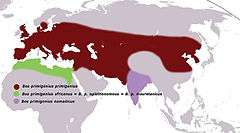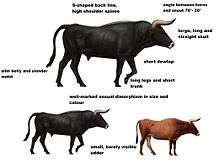Uruz Project

The Uruz Project is a project with the goal of breeding back the extinct aurochs (Bos p. primigenius). Uruz is the old Germanic word for aurochs. The Uruz Project was initiated in 2013 by the True Nature Foundation[1] and presented at TEDx DeExtinction, a day-long conference[2] organised by the Long Now Foundation with the support of TED and in partnership with National Geographic Society,[3] to showcase the prospects of bringing extinct species back to life. The de-extinction movement itself is spearheaded by the Long Now Foundation.
Technically, Bos primigenius is not wholly extinct. The wild subspecies B. p. primigenius, indicus and africanus are, but the species is still represented by domestic cattle. Most, or all, of the relevant Aurochs characteristics, and therefore the underlying DNA, needed to "breed back" an aurochs-like cattle type can be found in B. p. taurus. Domestic cattle originated in the middle east, and there also has been introgression of European aurochs into domestic cattle in ancient times.[4] The Uruz Project’s goal is to collect all relevant data and reunite scattered aurochs characteristics, and thus DNA, in one animal.
The project differs from other, historical and more recent, aurochs breeding projects in that it combines genomics and classic Mendelian rules of inheritance to develop the most effective breeding strategy. Primitive founder cattle breeds are carefully selected and the number of cattle breeds used is kept to a minimum.
Background

Ecological restoration projects cannot be complete without bringing back those key elements that help shape and reshape wild landscapes. The European aurochs (Bos p. primigenius) was a large and long-horned wild bovine herbivore that existed from the most western tip of Europe until Siberia in present-day Russia. Aurochs have played a major role in human history. They are often depicted in rock-art, including the famous, well-conserved cave paintings made by Cro-Magnon people in the Lascaux Caves, estimated to be 17,300 years old. Aurochs and other large animals portrayed in Paleolithic cave art were often hunted for food. Hunting and habitat loss caused by humans, including agricultural land conversion, caused the aurochs to go extinct in 1627, when the last individual, a female, died in Poland’s Jaktorów Forest.[5]

The aurochs is one of the keystone species that is missing in Europe. Their grazing and browsing patterns, trampling of the soil and faeces had a profound impact on the vegetation and landscapes it inhabited. Grazing results in a greater variety of plant species, structures and ecological niches in a landscape that benefit both biodiversity and production.[6] Megaherbivores like the aurochs also controlled vegetation development.[7] The Uruz Project ultimate goal is to breed back the aurochs to re-create, maintain and enhance the biodiversity and characteristics of natural ecosystems in Europe.
Breeding strategy
The Uruz Project aims to breed an aurochs-like breed of cattle from a limited number of carefully selected primitive cattle breeds with known Aurochs characteristics. The project uses Sayaguesa cattle, Maremmana primitiva or Hungarian grey cattle, Chianina and Watusi. The genome of the Aurochs has been completely reconstructed and serves as the baseline for the reconstruction of the Aurochs.[4][8]
The project plans to use aurochs DNA data to evaluate breeding results and genome editing, a new field of science, to eliminate wrong genes so that characteristics that are not aurochs-specific will not inherit and return in later generations.
In order to obtain the desired features of two breeds in one breed, the project conducts crossbreeding with two cattle breeds within one crossbred combination. The F1 will be (virtually) homogeneous. Crossbreeding those F1's with one another will theoretically result in all phenotypes within the phenotypic bell curve of a breed A or breed B and the morphology of both breeds. Two breeding lines have been set up with two breeds per breeding line, i.e. one breeding line of Chianina × Watusi and the other breeding line Sayaguesa × Maremmana. Once the Chianina × Watusi and Sayaguesa × Maremmana offspring of the (true) F2 are available in both sexes, the project will continue with a (true) F3 while continuing to raise additional (true) F2 from the F1 generation over the course of their reproductive lifetime. By adhering to this breeding strategy more stability will be created than with random crossing based on phenotype.
Two Aurochs-like breeds have been chosen that will be bred without crossing-in other breeds. Only selection will be used as a tool to breed towards an aurochs-like morphology. These two are the Barrosã and Maronesa cattle breeds from Northern Portugal.[9]
Selection criteria

For assessment and definition of Aurochs appearance and behaviour, the Uruz Project integrates knowledge and expertise from multiple scientific disciplines, including archaeozoology, archaeology, cattle breeding, ecology, zoological forensic research, ancient genetics and molecular biology. Physical selection criteria have been established for both bulls and cows. This includes both phenotype, including shoulder height, overall build, coloration, head, horns and coat, and socioecological behaviour and use of terrain and vegetation.
Cross breeding progress and results
The first breeding herds have been established in Germany and in the Netherlands. Preparations are underway to start multiple herds in Portugal, Spain, Czech Republic and Romania.
Partnerships
The Uruz Project established long term partnerships with the Long Now Foundation, Kloster Lorsch, Förderkreis Große Pflanzenfresser im Kreis Bergstraße e.V, European Wildlife, SAVE Foundation, as well as the Animal Genomics Laboratory of Dublin University, the Ancient DNA Laboratory at Potsdam University and genomics laboratories in the United States.
See also
References
- ↑ "Uruz Project". True Nature Foundation. Retrieved 11 May 2014.
- ↑ "TEDxDeExtinction". TED.
- ↑ "De-Extinction : Bringing Extinct Species Back to Life". National Geographic.
- 1 2 Edwards, CJ; Magee DA, Park SD, McGettigan PA, Lohan AJ, Murphy A, Finlay EK, Shapiro B, Chamberlain AT, Richards MB, Bradley DG, Loftus BJ, MacHugh DE.; Park, S. D.; McGettigan, P. A.; Lohan, A. J.; Murphy, A; Finlay, E. K.; Shapiro, B; Chamberlain, A. T.; Richards, M. B.; Bradley, D. G.; Loftus, B. J.; Machugh, D. E. (2010). "A complete mitochondrial genome sequence from a mesolithic wild aurochs (Bos primigenius)". PLoS ONE. 5 (2): e9255. doi:10.1371/journal.pone.0009255. PMC 2822870
 . PMID 20174668.
. PMID 20174668. - ↑ Tikhonov, A. "Bos primigenius. The IUCN Red List of Threatened Species.". IUCN.
- ↑ Iain J. Gordon; Herbert H. T. Prins (2008). The Ecology of Browsing and Grazing. Springer. pp. 263–292. ISBN 978-3-540-72421-6.
- ↑ Jill, JL (2014). "Ecological impacts of the late Quaternary megaherbivore extinctions". The New Phytologist. 201 (4): 1163–1169. doi:10.1111/nph.12576. PMID 24649488.
- ↑ Stephen D.E. Park, David E. MacHugh; David A. Magee, Paul A. McGettigan, Matthew Teasdale, Ceiridwen J. Edwards, Amanda J. Lohan, Alison Murphy, Yuan Liu, Emma K. Finlay, Steven G. Schroeder, Daniel G. Bradley, Tad S. Sonstegard, Brendan J. Loftus (January 11–16, 2013). "A Complete Nuclear Genome Sequence from the Extinct Eurasian Wild Aurochs (Bos primigenius)". Plant and Animal Genome XXI Conference, San Diego, CA. Retrieved 11 May 2014.
- ↑ "Uruz Project - Portugal's key role in conservation of ancient cattle breeds". Algarve Wildlife. Retrieved 12 May 2014.
External links
- Aurochs at the True Nature Foundation
- Long Now Foundation
- Uruz Project on Facebook